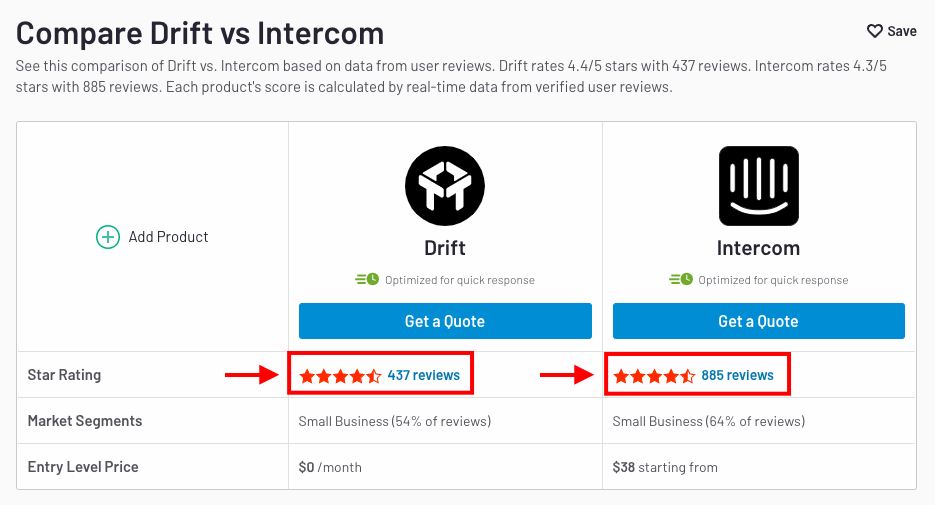Article's Content
Hey there, marketing pro! Welcome to the Live Chat Wars.
What exactly are the Live Chat Wars, you ask?
Drift vs Intercom—only one live chat tool can come out on top.
The goal of this isn’t to compare the two from a product standpoint—our goal is to compare them from a marketing strategy standpoint. We’re looking into what they’re both doing marketing-wise.

(Before we dive in, let me add a quick qualifier here. Yes, Drift & Intercom are both much more than *just* live chat tools. The reason we’re still rolling with “live chat wars” is because the live chat features have been what their known for the most. Sound good? Awesome.”
The war for users has existed since the beginning of the internet. We’ve had Google vs Yahoo, Apple vs Samsung, Instagram vs Snapchat and now, Intercom vs Drift. And honestly it’s been one of my favourites so far.
Let’s jump in.
The tale of the tape…
If you’re anything like me, you’ve been watching the ruthless battle for the live chat throne play out over the past year. We’ve seen the “chat bot” concept pop up on marketing blogs in their prediction posts for what strategies would dominate the following year since 2015. But in 2019, they really came out to the battlefield.
As the eCommerce and B2B landscapes start to shift and marketers weigh connections with customers more heavily, the need for a simple and effective communication channel directly on their website grows.
At this point, most marketing marketing platforms are offering some type of live chat feature available. Whether it’s Salesforce, Hubspot, Marketo, ActiveCampaign or even Facebook.
But in B2B, two companies have emerged as the go-to solution: Drift & Intercom.
A quick peek at the G2 comparison shows how close they appear to be in terms of customer ratings:

4.5 stars for Drift.
4.5 stars for Intercom.
Their key differentiator?
Combining departments rather than fuelling silos.
Let’s break down that concept…
Rather than having an overcomplicated funnel and one communication tool for your sales team, one tool for your marketing team, and one more tool for your success and support teams—both Intercom and Drift have developed platforms that allow all three departments to utilize one tool.
And the benefits aren’t just streamline how your company operates internally. The point of contact for your customer becomes much easier and provides a smoother experience for them overall.
But why do we even need live chat?
Think of it this way…
You walk into a store with the intent to purchase something. You have a general idea of what you’re looking for but you have a couple questions first.
Now imagine that store you walk into, with questions, has a grand total of zero people working. Nobody around at all to answer your questions. What are you going to do?
Leave.
You’re going to leave without giving them any money, and you’ll pop down the road to that store’s biggest competitor who *does* have someone there to answer your questions.
Well, that’s pretty much how businesses online are working too.
Their stores are empty with no representatives ready, and waiting, to chat with prospects to help move them further down the funnel.
And I know what you’re thinking—don’t we do that with our ebooks and our pop ups and our blog posts and our Q&A sections? And the answer is, kind of.
Your pages and pages of FAQs might answer something that’s similar to their questions, but every customer is going to have a different perspective and a different set of needs—having someone live that can answer their exact question when they’re looking to buy is key. In some cases, it’s even been proven to boost conversion rates by 30-50%.
The live chat wars: A brief history
With how fast markets and businesses are able to grow today, you can’t just ignore your competition completely.
You’ve likely been told to “focus on your own business; your competitors will only distract you.”
Unfortunately, this doesn’t really apply anymore. In fact, it’s the exact opposite—you need to look at your competition in order to stay one step ahead of them and to better understand what it is your customer wants and needs from you.
There is no better example of success with this particular strategy than the marketing battle between Intercom and Drift.
Intercom had already rightfully been crowned with the live chat throne in the B2B space for some time when Drift entered the scene with products that looked “inspired” by some of Intercom’s solutions. At that point, the live chat wars began.
As Drift started winning market share, Intercom copied (and arguably improved on) Drift’s best selling features.
Then Drift shifted their focus to sales and lead generation, and surprise, surprise—Intercom again followed in their footsteps.
Not because they’re lazy, uncreative, or vindictive, but because they know if they really want to compete in today’s SaaS marketplace, you can’t ignore your competitors.
You have to stay ahead of the curve. You might be able to convince your friends and family that you’re the best because you were “here first” or have a better “vision”, but pretty much every single one of your customers won’t care.
Despite Intercom fighting back, Drift didn’t back down…
Good marketers copy, great ones steal
I heard this concept on a podcast a few months ago and it might leave a bad taste in your mouth at first, but hey—the truth hurts sometimes.
This is exactly what Intercom and Drift are doing behind the scenes with these landing pages. Intercepting competitor traffic and either changing the minds of prospective competitor customers, or convincing existing ones to switch over.
And it goes deeper than just ranking for “Drift vs Intercom” and “Intercom vs Drift” with these pages as well—take a look:

When someone searches for “Drift vs Intercom” in Google, Drift is paying to be at the top of the results page. They want to be the first name you see, and they want to control the narrative of which company is better, using their own comparison page.
Intercom was doing the same in late 2018—the word “drift” was actually one of their top five PPC keywords:

But as of today, there is no “drift” in sight it seems:

Interesting decision.
If you jump onto Google to compare the two, you’re going to see a whole lot of Drift at the top of the results page and no Intercom in sight (except for the mention of “Intercom alternatives“.
Here’s “Drift vs Intercom”:

And “Intercom vs Drift” looks the same:

If you want to see Intercom at all, you’ll have to scroll.
These “alternative to” landing pages are a great way to stand out in a competitive market. If you’ve built up some brand equity and potential customers are looking to compare you with a competitor by name, that’s traffic you *need* to capture. Let your competitor set the stage for the comparison and you’ll lose every time.
A solid brand identity can go a long way, too
Speaking of brand equity…
The live chat wars (and any battle between competitors for that matter) isn’t always about getting down in the mud and fighting dirty. There are some other really cool things these two brands have done that have contributed to their spot in the market.
Both companies have an established brand identity, and they lean into who they are as an organization within their marketing.
Drift isn’t just “live chat” and they’re upfront about that on their homepage:

They also coined the term “conversational marketing”, and now 400+ people are searching for it each month and plenty of companies are spending on Google Ads to show up:

Intercom also position themselves as more than just a live chat tool. They’re the solution to creating and maintaining better customer relationships:

For starters, Drift has been referred to as more like a reality TV show than a software company because of how transparent they are in their marketing channels. They use their Drift YouTube channel and their HYPERGROWTH podcast—between the two, they’re basically sharing everything they do at Drift.
One thing Intercom has always been known for is how creative they are. They have a massive design team, which they celebrate and embrace much like they way mailchimp does, and their content always looks good.
They showcase this even more so with one of my favourite instagram accounts to follow @IntercomBrandStudio, where they highlight the best designed content of the week.

These things have less to do with converting leads directly, and are much more focused on showcasing their brand and culture. Long-term, a positive brand image and publicly awesome-looking culture are going to lead to business growth (and make recruiting a whole lot easier.)
What are they doing similarly?
At first it was pretty easy to spot the similarities between the two in messaging—Drift being “the new way businesses buy from businesses” and Intercom being the “new and better way to acquire, engage and retain customers.”
Both were positioning themselves as a new and exciting marketing strategy and following up with engaging customer case studies that lead with eye-catching stats…
Intercom: How Unity’s inside sales team drove 80% of its revenue through live chat
Drift: IT Software Company Books $3.6 Million Of Pipeline In Their First 8 Months Using Drift
But the Live Chat war doesn’t stop at similar messaging. It flows deeper than that. Check out both of their “alternative to” pages:
Here’s Intercom:

And here’s Drift:

That’s right, both companies have invested in creating effective landing pages where the one and only focus is talking about why their product is better than the other.
Why does this work?
Here’s the big reason:
If you’re a marketer looking into live chat software to help grow your business, one of your first questions might be… “Well, which one is best for me?”
And here you have two landing pages that will break down exactly what one does better than the other, straight from the horse’s mouth.
What does this all mean for you?
Now that you know all about the Live Chat Wars and the strategies that both Drift & Intercom are using to set themselves apart—you may be asking yourself:
“Okay, great—but what does that have to do with me?”
Well, even if you’re not your own version of a “Live Chat War”, there may be a new competitor coming up that will throw you into the battle. And you need to be ready for it. Take the time now to look at the ways that set you apart from any potential competition, and build on it.
You want to start building a moat around your business today to keep those future (and current) competitors away.
If you are in a battle yourself, spend some time looking at your competition’s website and products.
- What do they do that you don’t?
- What do you do better than them?
- What messages are they promoting front & center?
- Who are their ideal customers?
Create your own list of things that set you apart from your competition and test out some of the strategies Drift & Intercom have been using in their Live Chat War. You might find that these strategies will help you to beat out your competition.
In the meantime, We’d love to know your thoughts on these strategies. Let me know what you think in the comments below!
(P.S. If you’re working at Drift or Intercom right now & reading this, we’d love to get your take on the live chat war. Leave a comment below or let us know on Twitter—all takes are welcome. 🔥)
[Updated Dec 09, 2021]








